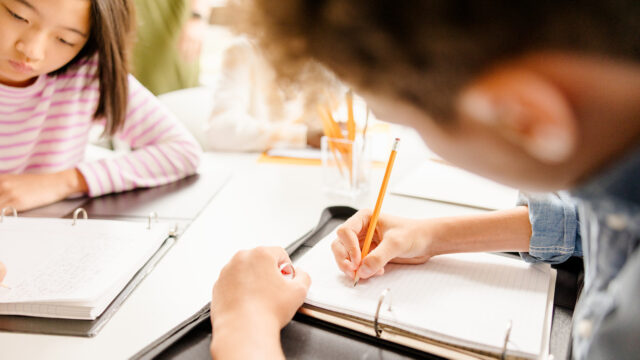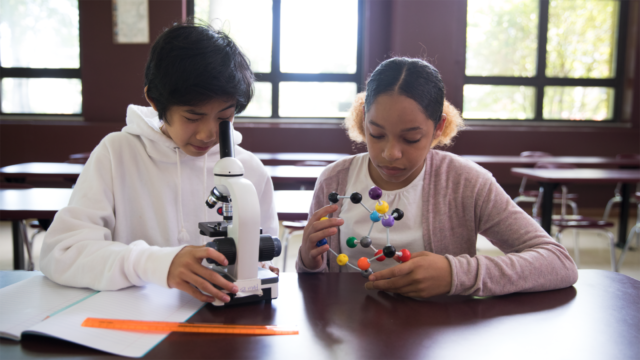
Fall brings a certain kind of magic for many. Depending on where you live, there’s a break from hot summer days, and, in many places, the weather isn’t too cold. Plus, the changing leaves create a beautiful landscape worth traveling to see. It’s no wonder why some of us can’t wait for this season!
Fall science activities for elementary students
Plenty of fall themes are worth studying during the season. Try any of our seven fall science activities for elementary students. Some of our ideas require students to head outdoors, while others allow them to study the season from the comfort of the classroom.
Activity 1: Signs of the season, Grades K–5
- Key Standard: Plan and conduct an investigation to describe and classify different kinds of materials by their observable properties.
- Key Standard: Make observations of plants and animals to compare the diversity of life in different habitats.
From crisp air to migrating animals, there are plenty of signs that autumn has arrived. Challenge students to spot a few or all of the animals and natural fall sightings below. They can complete this activity independently throughout the season or while on a nature walk.
Squirrels gathering acorns |
Colorful leaves |
Leaves at different stages of decomposition |
Piles of leaves |
Migrating birds |
Spiderwebs |
Pinecones |
Mushrooms/fungi |
Pumpkins |
Bonus: A bat (If you’re lucky) |
Activity 2: Recycling pumpkins, Grade K
- Key Standard: Generate and compare multiple possible solutions to a problem based on how well each is likely to meet the criteria and constraints of the problem.
Pumpkins are synonymous with fall for many people. However, once the season begins to die down, many of these orange-colored squash varieties are at risk of going to waste. According to one article, billions of pounds of pumpkins end up in landfills each year during the Halloween season. Spare a few by engaging students in a recycling activity. Encourage students to brainstorm how they can reuse pumpkins. For example, they can upcycle or use parts of a pumpkin in one of the following ways:
- Carve out the interior of a pumpkin and design the exterior however you please. Then, place a candle inside for a fall-themed centerpiece.
- Roast the seeds for a delicious and nutritious treat. Try this simple recipe, provided by UC Berkeley’s health services team.
- Paint your pumpkin for seasonal decor.
After getting a few more uses out of the pumpkins, you can dispose of them in a compost or yard waste collection. Download the following resource to teach students about composting.

Activity 3: Autumn animals, Grades K–5
- Key Standard: Make observations of plants and animals to compare the diversity of life in different habitats.
- Key Standard: Use observations to describe patterns of what plants and animals (including humans) need to survive.
Have students choose an animal that commonly appears during fall, such as an owl, bat, squirrel, or red fox. Then, have students create a poster that includes facts about the animal. Afterward, hang and display the posters throughout the season. Facts can include:
- Common and scientific name
- Diet
- Size
- Average life span
- Natural habitat
- Parts of the world the animal lives in
Activity 4: Nighttime fall sky, Grade 5
- Key Standard: Use observations of the sun, moon, and stars to describe patterns that can be predicted.
The cooler weather and extended nights during the season make for an ideal time to study the nighttime sky. The activity guides below provide activities for students to learn more about the moon’s phases and constellations.
Tracking the moon’s phases
Have students study the sequence of moon phases in one month; then, have students fill in the missing phases in a partially empty calendar. Consider taking this activity further by having students observe the moon’s phases for an entire week or any month during the season. They can use the model provided in the resource below and draw the correct shape depending on the day.
Studying the constellations
Show students images of how constellations change with the seasons. Then, have students fill out a data chart to record whether they can view certain constellations during particular seasons. Take this activity outdoors by having students identify the constellations visible during fall. You can download a free app to determine what will be visible throughout any given month; NASA also provides a hub full of resources to support stargazing.

Activity 5: Vegetable sorting, Grades K–5
- Key Standard: Make observations of plants to compare the diversity of life in different habitats.
Fall harvest brings about an abundance of vegetables. Why not teach students about the varieties? Have each student bring in one or two vegetables. Then, have students sort them by color, size, shape, and texture. Alternatively, have your students research and print out pictures for this activity, or they can use photos from newspapers or magazines. However, if you plan to use photos instead, it might be difficult to sort by texture.
After students learn more about the variety of vegetables, have them choose one to study more. They can delve into the health benefits, nutrition facts, and common uses. They can use this information to persuade others to try their chosen veggies.
Activity 6: Leafy matters, Grade 4
- Key Standard: Plan and conduct an investigation to determine if plants need sunlight and water to grow.
- Key Standard: Conduct an investigation to determine whether the mixing of two or more substances results in new substances.
Have students think about how trees usually appear in spring, winter, summer, and fall. For example, summer trees are usually lush and full of leaves, while trees in winter are mostly bare. Students can draw their own images to show how trees change with the seasons. Then, have students study how light affects these changes using the below activity. They will answer the question: what factors might affect when a tree begins to lose its leaves?

Help students learn more about leaves through an activity where art meets science. They will have the chance to extract the pigment of green, yellow, and red leaves using crushed leaves, alcohol, and paper strips. This blog post by Davidson Lands Conservancy delves more into the activity, plus provides fun art projects that allow students to use their crushed leaf mixtures.
Activity 7: Fall phenomena, Grades 3–5
- Key Standard: Represent data in tables and graphical displays to describe typical weather conditions expected during a particular season.
Have you heard of the Shadow of the Bear, a phenomenon that takes place twice every year in North Carolina? From mid-February to early March and from mid-October through early November, when the sun is at the perfect angle as it sets behind Whiteside Mountain, the phenomenon appears (read more about it in this article). Have students research a phenomenon that occurs during fall. Then, have them present their findings through a report or on a poster. They can include:
- The name of the phenomenon and a definition
- A photo or drawing of the phenomenon
- Where the phenomenon usually occurs
- Facts about the phenomenon that students find interesting
Preparing for winter? Try one of these science activities that touch on a range of cold weather-related topics. For fall activities that cover all subjects, read this blog.
Share your autumn science experiments and projects
What are some of your favorite, easy fall science experiments and activities? Share your fall science projects with us via email at shaped@hmhco.com or reach out on Instagram or Facebook.
***
Like our fall-themed science experiments and activities? Learn more about how hands-on learning within HMH’s science curriculum helps students forge a deeper understanding of scientific concepts.
Be the first to read the latest from Shaped.














